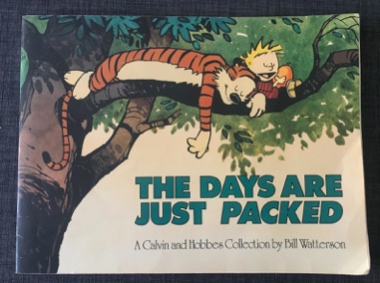Pre-lockdown, the only reading I managed was cramming four chapters of “All Quiet on the Western Front” into my brain the night before the test.
It’s not that I don’t like reading. In fact, before the stress of high school kicked in, reading was my favorite pastime. But as my days became consumed with homework, tutoring and sports, my time for recreational reading slowly dissipated.
Now that I have endless time, I’ve found myself picking up countless books in my house, from “Diary of a Wimpy Kid” by Jeff Kinney, to Steven Hawking’s “Theory of Everything.”
Recently, I came across a comic book the size of three books put together titled “Calvin and Hobbes: The Days are Just Packed.”
Flipping it open, I saw the first page had a note addressed to my dad from his childhood family friend. The loopy handwriting was practically illegible, but I deduced that it was a birthday present to my dad for his 8th birthday.
I was excited to be holding a book that my dad enjoyed in his childhood and wanted a look into what his life was like when he was younger. Eagerly, I began reading in hope that I would find it interesting as well, even in my teenage years.
Once I got into the book, I quickly figured out that it depicted the stories of a young boy named Calvin and his imaginary tiger friend, Hobbes. The pair go on crazy adventures, fueled by Calvin’s imagination and mischievous tendencies.
Each page is its own mini comic strip and has no correlation to the next, although they all involve Calvin getting himself into trouble and blaming it on Hobbes. While I wish that the plot was more consistent, it’s entertaining to see what each page will have in store, as each comic strip was originally run individually in newspapers.
One of my favorite panels is one where Calvin and Hobbes ambush Susie, a know-it-all in their class, with snowballs. They hurl the snowballs at Susie, who becomes hilariously infuriated and proceeds to snitch on the boys to any adult in earshot.
Throughout the series, Calvin, who is extremely intelligent for a 6-year-old, asks probing questions to his teacher, ranging from his beliefs on secularism to the moral dilemma behind subtraction problems. He asks his teacher, “One of them is going to get subtracted, but why? How? What will be left of him?” These questions often land him in the principal’s office.
Laughing over the ways Calvin finds himself in trouble, I finished the book in just an hour. This was not only because it was easy to read and illustration-heavy, but also because I truly enjoyed looking at life from Calvin and Hobbes’ perspective, where anything seems possible and everything should be questioned.
It’s refreshing to have an opportunity to step away from the classic literature that we are required to analyze in school. When I read a timeless comic like “Calvin and Hobbes,” I found myself wanting to continue reading and discover what adventure lay in store.
























